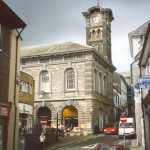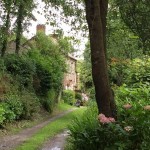Thursday Thoughts: Characters!
My book tour in Cornwall in July brought up a lot of memories. Here is one that I have added to my “Memoirs While Memory lasts” about some wonderful characters in my boyhood.
When I was a little boy my favorite aunt was Aunty Betty. On second thoughts she was one of my favorites. There were lots of aunts to choose from and they were all pretty nice and inclined to spoil small nephews. My mother was one of ten children, five boys and five girls. Like many of their generation two were spinsters, their fiancés killed in the Great War. My father had one sister, Hilda, who was very interesting but lived a long way away in Wadebridge where my father was born. You had to hire a car to drive the twenty miles. Rarely done. However, they all lived in Cornwall.
Part of the reason why Aunty Betty was a favorite was that she always gave me £5 at the beginning of every school term. That was in the days when £5 notes were bigger than £1 or 10 shilling notes and printed on one side of crisp white paper, the kind called banknote. £5 was worth so much then that whenever a note changed hands you signed your name on the back. My mother said that Aunty Betty was comfortably off and could well afford it. She had been widowed twice and both of her husbands left her quite a bit of money.
She had a stepson with one of them, Uncle Rodgy. He was a retired tea planter from India, a bachelor, and lived in rooms with Mrs. May at the end of Manley Terrace. He had a gimpy leg and walked with a cane but went down every day to The Stag just before lunch. My mother said he drank. He was a dry old stick and used to tell me stories with a raspy smoke rough voice. He gave me some serious advice. “Don’t marry for money, my son, but be near where ’tis.”
However, Aunty Betty was a tough old bird and she made her feelings known, especially when I slipped into the habit of only seeing her three times a year, once at the beginning of every term. She was used to being frank with her opinions. She had retired as matron of the Bristol Royal Infirmary and she was not persnickety about dealing with little boys who needed to pee and poop. Apparently she had terrified the young nurse probationers at the hospital. She was still in charge when my big sister Pat went there to qualify as a physiotherapist. Pat admired her. The war was still on and during the blackout Aunty Betty used to walk her home at night through the rougher city streets, protecting her from the young servicemen keeping themselves cheerful with too much beer.
Before we moved, we used to live next to Aunty Betty. My Uncle Dick built our houses. My father thought Aunty Betty was bossy, although he usually kept that to himself. The nice thing about her house was that it had concrete paths. These were much better for my little red pedal car than our gravel paths, so I spent a lot of time there. She lived alone upstairs and rented the ground floor to a retired farmer and his wife. When I visited her she would give me a Jacob’s Cream Cracker with butter, scraped thin because it was rationed.
I especially enjoyed sitting at her front window looking out and waiting for Ernie Penna to arrive. Poor old Ernie didn’t have very good jobs because he wasn’t right in the head and couldn’t speak clearly. He was a well known local character. Every day he would walk down to the railway station to pick up the evening newspapers from Plymouth and come back up Station Road with them in a canvas bag slung over his shoulder. He also carried a long pole and lit the gas lamps along the street as he went. Ernie would call out, “Eeran Errol”. If you were in the know, you knew that was Evening Herald. Aunty Betty would give me a penny and I would run out across the street to buy her paper from Ernie.
Just a month or two after the war ended the Labour Party withdrew from the coalition government. Parliament was dissolved on June 15 and there was a general election. We were all very excited. People expected Winston Churchill and the Conservatives, the Tories, to win in gratitude for his inspiring war leadership. Our family was Liberal. My father particularly admired the great Isaac Foot who had been our M.P. before the war. Mr. Foot’s father had been a humble carpenter. Isaac educated himself and became a lawyer, a solicitor, in the nearby city of Plymouth, although he lived in Cornwall. He was a student of Oliver Cromwell, a Methodist lay preacher, and an ardent teetotaler. He became lord mayor, was elected to the House of Commons and rose to being the Secretary for India in the last Liberal government.
Isaac Foot had five sons and every morning at breakfast each son had to make a one minute speech. That practice stood them in good stead. They all went to Oxford and three became presidents of the Union, the debating society. Hugh went into the Colonial Service and triumphed as the last Governor of Cyprus. His brothers said that he loved dressing up in fancy uniforms. However, he settled the intractable Cypriot civil war between the Greeks and the Turks. His reward was a peerage and he retired as Lord Caradon, named after the Cornish tin mine near his father’s home.
Dingle Foot went into law and was elected M.P. for North Cornwall. After the death of his father, and indeed virtually the Liberal Party, Dingle joined the Labour party, became the Solicitor General and was knighted. John was the Liberal Candidate for Southeast Cornwall in the 1945 election, of which more anon, joined the family solicitor’s practice and later became Baron Foot.
Michael was Isaac’s secret favorite. He was strongly anti-fascist and a rabid socialist, taking his father’s progressive politics a big step further. As a young man he was a hard-hitting and widely read London journalist. He was elected M.P. for Devonport and became an effective and passionate orator in the House of Commons. He rose to become the parliamentary leader of the Labour Party and would have become prime minister had Labour won the election. True to his principles he refused the peerage offered him upon retirement.
The youngest son, Christopher, led a private life spent with the family firm of solicitors. His reputation is that of a delightful man, an able lawyer and of the highest integrity.
When I became president of the Oxford University Liberal Club, charged with putting together a program, I invited both Dingle and John Foot to come and speak. Both were kind enough to accept. John was even kinder and gave me a speaking tip. I had been asked to be a paper speaker at the Union and was a bit nervous about introducing the debate. John told me to soften up the critical audience with humor and gave me his father’s favorite joke. As I later stood at the dispatch box, I intoned with what I trust passed as originality, “One must not think that the Church of England is the Tory party at prayer.” Appreciative chuckles reverberated through the debating hall.
One of my proudest possessions is the cut crystal fruit bowl given me as a wedding present by Isaac Foot. These memories were in my mind when I visited Liskeard, my home town, during my book tour with my daughter Sarah in July. Then one of our daily synchronicities happened. Being from Boulder, she was tickled to see a car with Colorado license plates. That afternoon I gave a talk at the Liskeard Public Library, complete with a Cornish cream tea. The enthusiastic librarian introduced herself as Tracee Foot. She turned out to be the owner of the car.
“Foot?” I asked. Her husband proved to be Jesse Foot, grandson of Michael. They met at university in Colorado and decided to settle in Cornwall after they married. We arranged to have tea the next day, a delightful opportunity to get to know them and learn of Jesse’s political ambitions. It must run in the family.
Well, speaking of elections, my first campaign was supporting John Foot in 1945. He and his supporters had to move fast with the campaign lasting only three weeks. As a boy I was more enthusiastic than valuable but my biggest sister Pam was fantastic. When she was at Cambridge (which we Oxonians disparaged as a technical college in the fens!), like Michael Foot she strayed to the left of traditional Cornish liberalism. She had been impassioned by the Spanish Civil War when Cambridge undergraduates had fought against Franco’s fascists. For a while she thought that Karl Marx made a lot of sense.
She campaigned for John Foot all over the countryside, warming up the crowds in the towns and villages with eloquence, erudition, passion and humor. She was particularly effective in attacking the Tory candidate, Commander Douglas Marshall, R.N. He was a novice and not yet an imaginative speaker. His speech was a variation of three repeated themes delivered in a plummy accent that my sister parodied with barbed wit. “I believe in a strong navy, a strong army, and a strong air force. Furthermore, I am convinced of this country’s need for a strong air force, and a strong army as well as a strong navy. To which I would add . . .” And so forth.
I should not be too hard on him. He did get elected. Later when he came to speak to the Conservative Club at Oxford he was kind enough to invite me to dinner. I seized the opportunity to ask him for advice. “Commander Marshall, what is the secret of success as a Member of Parliament?” Without hesitation he replied, “Constitution of an ox, Richard my boy, constitution of an ox.”
On one memorable evening during the campaign Commander Marshall gave his familiar speech from the balcony of the Conservative Club at the end of Fore Street in the center of Liskeard, just below the Guildhall with its imposing clock tower. My sister Pam was part of the crowd listening below. The crowd was not spellbound by the oratory and grew restive. Among the distinguished supporters on the balcony behind the candidate Pam spotted none less than Ernie Penna, with his bag of newspapers slung over his shoulder. She also spotted an opportunity. She started a chant, “We want Ernie, we want Ernie!” The crowd picked it up. “We want Ernie, we want Ernie, we want Ernie,” drowning the speaker who simply gave up.
When a grinning Ernie stepped forward and spoke in his incomprehensible garble the crowd hooted and hollered. Commander Marshall never regained his composure or control of the crowd. The meeting broke up. John Foot’s supporters sensed victory.
Unfortunately, however, a Liberal victory was not to be. On election day on July 5 a Labour interloper had split the vote and the Conservative won. Cornwall once again ran against the national tide. The Conservatives were defeated, Labour won in a landslide and the Liberal Party was in tatters.
Aunty Betty, Uncle Rodgy, the Foots, my sisters, Douglas Marshall, Ernie Penna. What characters! What a boyhood.
© Richard Hoskin 2015


















